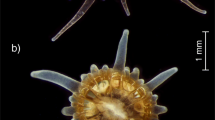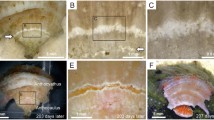Abstract
Coral has strong regeneration ability, which has been applied for coral production and biodiversity protection via tissue ball (TB) culture. However, the architecture, morphological processes, and effects of environmental factors on TB formation have not been well investigated. In this study, we first observed TB formation from the cutting tentacle of scleractinia coral Goniopora lobata and uncovered its inner organization and architecture by confocal microscopy. We then found that the cutting tentacle TB could self-organize and reform a solid TB (sTB) in the culture media. Using chemical drug treatment and dissection manipulation approaches, we demonstrated that the mechanical forces for bending and rounding of the cutting fragments came from the epithelial cells, and the cilia of epithelial cell played indispensable roles for the rounding process. Environmental stress experiments showed that high temperature, not CO2-induced acidification, affected TB and sTB formation. However, the combination of high temperature and acidification caused additional severe effects on sTB reformation. Our studies indicate that coral TB has strong regeneration ability and therefore could serve as a new model to further explore the molecular mechanism of TB formation and the effects of environmental stresses on coral survival and regeneration.








Similar content being viewed by others
References
Berkelmans R, De’ath G, Kininmonth S, Skirving WJ (2004) A comparison of the 1998 and 2002 coralbleaching events on the Great Barrier Reef: spatial correlation, patterns, and predictions. Coral Reefs 23:74–83. doi:10.1007/s00338-003-0353-y
Castillo KD, Ries JB, Bruno JF, Westfield IT (2014) The reef-building coral Siderastrea siderea exhibits parabolic responses to ocean acidification and warming. Proc R Soc Lond B 281:20141856. doi:10.1098/rspb.2014.1856
Domart-Coulon I, Tambutté S, Tambutté E, Allemand D (2004) Short term viability of soft tissue detached from the skeleton of reef-building corals. J Exp Mar Bio Ecol 309:199–217. doi:10.1016/j.jembe.2004.03.021
Doney SC, Fabry VJ, Feely RA, Kleypas JA (2009) Ocean acidification: the other CO2 problem. Ann Rev Mar Sci 1:169–192. doi:10.1146/annurev.marine.010908.163834
Dove SG, Kline DI, Pantos O, Angly FE, Tyson GW, Hoegh-Guldberg O (2013) Future reef decalcification under a business-as-usual CO2 emission scenario. Proc Natl Acad Sct 110:15342–15347. doi:10.1073/pnas.1302701110
Feuillassier L, Martinez L, Romans P, Engelmann-Sylvestre I, Masanet P, Barthélémy D, Engelmann F (2014) Survival of tissue balls from the coral Pocillopora damicornis L. Exposed to cryoprotectant solutions. Cryobiology 69:376–385. doi:10.1016/j.cryobiol.2014.08.009
Frank U, Rabinowitz C, Rinkevich B (1994) In vitro establishment of continuous cell cultures and cell lines from ten colonial cnidarians. Mar Biol 120:491–499. doi:10.1007/BF00680224
Fujita K, Hikami M, Suzuki A, Kuroyanagi A, Sakai K, Kawahata H, Nojiri Y (2011) Effects of ocean acidification on calcification of symbiont-bearing reef foraminifers. Biogeosciences 8:2089–2098. doi:10.5194/bg-8-2089-2011
Gardner S, Nielsen D, Petrou K, Larkum A, Ralph P (2015) Characterisation of coral explants: a model organism for cnidarian–dinoflagellate studies. Coral Reefs 34:133–142. doi:10.1007/s00338-014-1240-4
Gates RD, Baghdasarian G, Muscatine L (1992) Temperature stress causes host cell detachment in symbiotic cnidarians: implications for coral bleaching. Biol Bull 182:324–332
Heisenberg C-P, Bellaïche Y (2013) Forces in tissue morphogenesis and patterning. Cell 153:948–962. doi:10.1016/j.cell.2013.05.008
Hoegh-Guldberg O, Mumby P, Hooten A, Steneck R, Greenfield P, Gomez E, Harvell C, Sale P, Edwards A, Caldeira K (2007) Coral reefs under rapid climate change and ocean acidification. Science 318:1737–1742. doi:10.1126/science.1152509
Huete-Stauffer C, Valisano L, Gaino E, Vezzulli L, Cerrano C (2015) Development of long-term primary cell aggregates from Mediterranean octocorals. In Vitro Cell Dev Biol Anim 51:815–826. doi:10.1007/s11626-015-9896-9
Kopecky EJ, Ostrander GK (1999) Isolation and primary culture of viable multicellular endothelial isolates from hard corals. In Vitro Cell Dev Biol Anim 35:616–624. doi:10.1007/s11626-999-0101-x
Kramarsky-Winter E, Loya Y (1996) Regeneration versus budding in fungiid corals: a trade-off. Mar Ecol Prog Ser Oldendorf 134:179–185
Kroeker KJ, Kordas RL, Crim R, Hendriks IE, Ramajo L, Singh GS, Duarte CM, Gattuso JP (2013) Impacts of ocean acidification on marine organisms: quantifying sensitivities and interaction with warming. Glob Chang Biol 19:1884–1896. doi:10.1111/gcb.12179
Lecointe A, Cohen S, Gèze M, Djediat C, Meibom A, Domart-Coulon I (2013) Scleractinian coral cell proliferation is reduced in primary culture of suspended multicellular aggregates compared to polyps. Cytotechnology 65:705–724. doi:10.1007/s10616-013-9562-6
Moberg F, Folke C (1999) Ecological goods and services of coral reef ecosystems. Ecol Econ 29:215–233. doi:10.1016/S0921-8009(99)00009-9
Muehllehner N, Edmunds P (2008) Effects of ocean acidification and increased temperature on skeletal growth of two scleractinian corals, Pocillopora meandrina and Porites rus Proceedings of the 11th International Coral Reef Symposium, Ft Lauderdale, Florida, pp 7–11
Nesa B, Hidaka M (2008) Thermal stress increases oxidative DNA damage in coral cell aggregates Proceedings of the 11th International Coral Reef Symposium, pp 149–151
Nesa B, Hidaka M (2009) High zooxanthella density shortens the survival time of coral cell aggregates under thermal stress. J Exp Mar Bio Ecol 368:81–87. doi:10.1016/j.jembe.2008.10.018
Pandolfi JM, Connolly SR, Marshall DJ, Cohen AL (2011) Projecting coral reef futures under global warming and ocean acidification. Science 333:418–422. doi:10.1126/science.1204794
Reynaud S, Leclercq N, Romaine-Lioud S, Ferrier-Pagés C, Jaubert J, Gattuso JP (2003) Interacting effects of CO2 partial pressure and temperature on photosynthesis and calcification in a scleractinian coral. Glob Chang Biol 9:1660–1668. doi:10.1046/j.1365-2486.2003.00678.x
Sabine AM, Smith TB, Williams DE, Brandt ME (2015) Environmental conditions influence tissue regeneration rates in scleractinian corals. Mar Pollut Bull 95:253–264. doi:10.1016/j.marpolbul.2015.04.006
Shapiro OH, Fernandez VI, Garren M, Guasto JS, Debaillon-Vesque FP, Kramarsky-Winter E, Vardi A, Stocker R (2014) Vortical ciliary flows actively enhance mass transport in reef corals. Proc Natl Acad Sct 111:13391–13396. doi:10.1073/pnas.1323094111
Stanley Jr G, Van De Schootbrugge B (2009) The evolution of the coral–algal symbiosis. In: M.J.H. van Oppen JML (ed) Coral Bleaching. Springer, pp 7–19
Tambutté E, Venn A, Holcomb M, Segonds N, Techer N, Zoccola D, Allemand D, Tambutté S (2015) Morphological plasticity of the coral skeleton under CO2-driven seawater acidification. Nat Commun 6:7368. doi:10.1038/ncomms8368
Tremblay P, Grover R, Maguer JF, Legendre L, Ferrier-Pagès C (2012) Autotrophic carbon budget in coral tissue: a new 13C-based model of photosynthate translocation. J Exp Biol 215:1384–1393. doi:10.1242/jeb.065201
Vizel M, Loya Y, Downs CA, Kramarsky-Winter E (2011) A novel method for coral explant culture and micropropagation. Mar Biotechnol 13:423–432. doi:10.1007/s10126-010-9313-z
Acknowledgments
We thank Xin Liang from Tsinghua University (Beijing, China) for generously providing technical guidance on circularity measure and calculation; and Mavis Adusei-Fosu for critical reading of the manuscript. This work is supported by National Natural Science Foundation of China (Grant No. 31472274 and 31172391), Regional Demonstration of Marine Economy Innovative Development Project (No.12PYY001SF08), National High-tech R&D Program of China (863 Program; Grant No. 2012AA10A402), and open funds of Institute of biodiversity and evolution, Ocean University of China (Grant No. 201362017). B. Dong is supported by Taishan Scholar Program of Shandong Province. This work is supported by National Natural Science Foundation of China (Grant No. 31472274 and 31172391), Regional Demonstration of Marine Economy Innovative Development Project (No.12PYY001SF08), National High-tech R&D Program of China (863 Program; Grant No. 2012AA10A402), and open funds of Institute of biodiversity and evolution, Ocean University of China (Grant No. 201362017). B. Dong is supported by Taishan Scholar Program of Shandong Province. All applicable international, national, and/or institutional guidelines for the care and use of animals were followed.
Author contributions
Q.L. performed all the experiments except confocal images capture, which were done by B.D. Q.L. and B.D. prepared all the figures. T.L. and X.T. provide regents and materials. H.G., B.D., and Q.L. analyzed the data, wrote the main manuscript text, and designed experiments. All authors reviewed the manuscript.
Author information
Authors and Affiliations
Corresponding authors
Ethics declarations
Conflict of interest
All authors declared no conflict of interest.
Additional information
Editor: Tetsuji Okamoto
An erratum to this article is available at http://dx.doi.org/10.1007/s11626-016-0110-5.
Electronic supplementary material
ESM Video S1
The cilia are clearly present in the surface of epithelial cells and swinging in the fragment of cut tentacle of coral.
ESM Video S2
The formed tentacle tissue balls are rotated in the culture media.
ESM Video S3
The TB fragment experienced bending process and formed a solid tissue body in the culture media.
The processes of 1/8 sTB reformation. The 1/8 TB fragment experienced rounding process and formed a solid tissue body in the culture media. (MOV 19076 kb)
The 1/8 sTB incubated in the Ca2+ free artificial seawater(CaFASW). The 1/3 sTB fail to reform in the Ca2+ free artificial seawater. (MOV 19063 kb)
Rights and permissions
About this article
Cite this article
Lu, Q., Liu, T., Tang, X. et al. Reformation of tissue balls from tentacle explants of coral Goniopora lobata: self-organization process and response to environmental stresses. In Vitro Cell.Dev.Biol.-Animal 53, 111–122 (2017). https://doi.org/10.1007/s11626-016-0095-0
Received:
Accepted:
Published:
Issue Date:
DOI: https://doi.org/10.1007/s11626-016-0095-0




